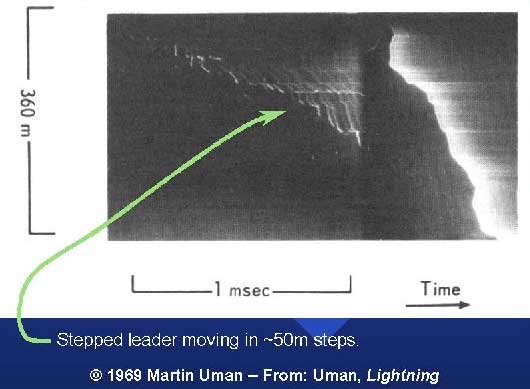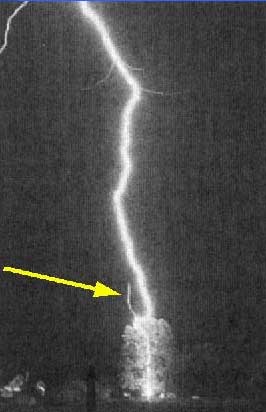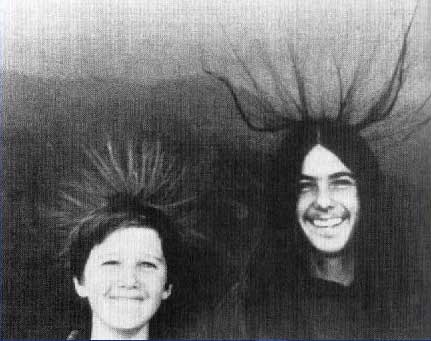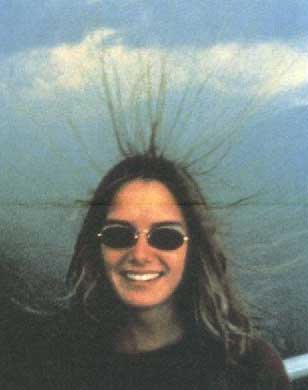What Is Lightning?
Lightning is a discharge of electrical energy.
Essentially a giant ìsparkî between regions of positive (+)
and negative (-) charge.
May
occur:
Between cells in the
same storm (inter-cloud lightning)
Within a cloud (intra-cloud
lightning)
Cloud to air
Cloud to ground (CG)
Why Do We Care?
National lightning safety institute (NLSI) reports
annual lightning damage at about $4-5 billion!
Formation of Lightning
Fair weather electric
field
Charge separation
Initiation of the lightning
stroke
Does lightning strike
twice? -- The mechanics of the lightning stroke
Kinds of lightning
Fair Weather Charge
In fair weather there is a natural separation
of charge in the atmosphere.
Fair Weather Circuit
Thunderstorms charge
the fair weather circuit.
Without thunderstorms, the fair weather charge separation would be neutralized
in about 10 minutes.
Lightning
Air is a very good insulator
(but not perfect).
To have lightning:
Need to have the charge
centers very close to each other
Have very large differences
in charge ìstrengthî
In order to get lightning
in a thunderstorm you need to separate large amounts of charge. How
is this done?
Cloud Charging Mechanisms
Poorly Understood!
Two Primary Theories on
Cloud Charging
- Collision Mechanism (Inductive Charging)
- Graupel Mechanism (Non-Inductive Charging)
Collision Mechanism
Precipitation particle (rain, snow, ice, etc.) is polarized by the ambient
electric field.
Collision between a falling large drop and a smaller one leaves a net negative
charge on the large drop and a positive charge on the small drop
Graupel Mechanism
During a collision between (unpolarized) heavy graupel particles and lighter
ice crystals:
Negative charge is transferred to the graupel
Positive charge is transferred to the ice crystals
Graupel falls to the bottom of the cloud bringing the negative charge with
it
Ice crystals are transported to the upper levels of the thunderstorm
Charge Separation
If the electric field, or the difference between the
negative and positive charge regions, is large enough, the insulator between
the charge regions (the air) breaks down and the lightning discharge can
occur between the regions of positive and negative charge.
The (CG) Lightning Stroke
The lightning stroke
begins when the electric fields exceed breakdown voltage. (We think!!!!)
Initially streams of
electrons surge from the cloud base toward the ground in steps of 50 to 100
m.
Start and stop steps
as the stepped leader progresses toward ground.

Figure 10.15 from Lutgens and Tarbuck ? The Atmosphere, 8th
Edition

Stepped Leader
The stepped leader is:
Very
Faint
Essentially
invisible to the human eye
Produces
an ionized channel that will allow for the flow of charge during the remainder
of the lightning stroke.

The photograph to the right shows a streamer emerging from the tree. Notice
how it did not connect to the stepped leader to complete the circuit.
When the stepped leader gets near the ground (~100 m
or so):
Positive charge moves
from the ground up toward the stepped leader -- these are called streamers
The
streamers may come from almost any pointed object on the ground:
Trees
Antennas
Grass
Flagpoles
Telephone Poles
People
Really Tall Towers Etc.
Return Stroke
One of the streamers
will meet the stepped leader -- not necessarily the one from the tallest
object!
When they meet a pulse
of energy flows up toward the cloud (along the ionized path) and toward the
ground.
This luminous pulse of
electrical energy is called the return stroke.
Occurs very fast -- we
see it as a flash!
Dart Leader
Often a second series
of stepped flow of electrons moves from the cloud toward the ground.
Since the ionized channel
already exists, the stepped flow is much faster.
This stepped flow is
called the dart leader.
Return Stroke
When the dart leader
connects with a streamer from the ground (usually along the same path) another
return stroke moves toward the cloud and ground.
May get several sets
of dart leader/return stroke pairs.
Appears as if the lightning
flashes.
Lightning Channel is not Always Straight!
Thunder
Lightning is very hot
(~30,000°C).
Violently expanding air
causes an audible shock wave.
Nearby Lightning - Thunder
sounds like a ìcrackî or a loud bang.
Distant Lightning - Thunder
sounds like a rumble. We are hearing the sound from different parts
of the lightning channel.
How far is that lightning????
Light travels much faster
than sound.
Count the time between
when you saw the flash and heard the thunder.
5 seconds per mile
3 seconds per km
Therefore ? if the
time between the flash and the thunder is 12 seconds, the lightning is 2.4
miles away, or 4 kilometers.
No thunder?
Could be too far away
Sound could be bent by
the atmosphere away from you.
Lightning Safety
No place is absolutely safe from the lightning threat,
however, some places are safer than others.
Substantially constructed
buildings
Fully enclosed metal vehicles
AVOID
Telephone, taking a shower, washing your hands, doing
dishes, or any contact with conductive surfaces with exposure to the outside
such as metal door or window frames, electrical wiring, telephone wiring,
cable TV wiring, plumbing, etc.
When outside AVOID:
High places and open
fields
Isolated trees
Unprotected places such as
gazebos, rain or picnic shelters, baseball dugouts, communications towers,
flagpoles, light poles, bleachers (metal or wood), metal fences, convertibles,
golf carts, water (ocean, lakes, swimming pools, rivers, etc.).
Make yourself as small
of a ìtargetî as possible with minimal ground contact


These two
photographs show apparent happy campers who don't realize that they may be
about to get hit by lightning. Notice where they are located? The
couple on the left are located high in the Great Smoky Mountains, above other
peaks, whereas the woman on the right is standing in a boat on the open water
in the Florida Keys. I guess these three haven't taken my Weather and
Climate class.
Lightning Protection
Lightning rods act as locations
where streamers can be launched toward descending stepped leaders.
It is better for the
lightning rods to be struck, where the electrical energy can be safely transferred
to ground, than the house.
The cone of safety is
about 45° under the lightning rod.
Lightning protection and safety devices
Lightning Protection
System (Rods, cables, etc.)
Surge suppressors
Well grounded equipment
Routine Testing and
Maintenance
Warning Devices
NOAA Weather Radio
Lightning detection
devices
Resuscitation Equipment
Lightning During the Day
Lightning
is more common during the day.
This is primarily due to the fact that more convection occurs during the day
and at dusk.
Lightning also occurs
at night over the oceans. Puzzling!
The
land cools much more than the oceans. Air over the warm oceans destabilizes
resulting in nocturnal convection.




